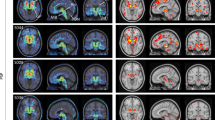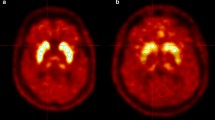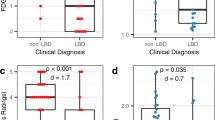Abstract
Purpose
First, to investigate the patterns of [18F]-FDOPA positron emission tomography imaging in corticobasal syndrome using visual and semi-quantitative analysis and to compare them with patterns found in Parkinson’s disease and progressive supranuclear palsy. Then, to search for correlations with clinical features and [18F]-FDG positron emission tomography imaging.
Methods
27 corticobasal syndrome patients who underwent [18F]-FDOPA positron emission tomography imaging were retrospectively studied. They were compared to 27 matched Parkinson’s disease patients, 12 progressive supranuclear palsy patients and 53 normal controls. Scans were visually assigned to one of the following patterns: normal; unilateral homogeneous striatal uptake reduction; putamen uptake reduction with putamen-caudate gradient. A semi-quantitative analysis of striatal regional uptake and asymmetry was performed and correlated to clinical features and [18F]-FDG positron emission tomography patterns.
Results
[18F]-FDOPA positron emission tomography appeared visually abnormal in only 33.5% of corticobasal syndrome patients. However, semi-quantitative analysis found putaminal asymmetry in 63%. Striatal uptake was homogeneously reduced in both putamen and caudate nucleus in corticobasal syndrome patients unlike in Parkinson’s disease and progressive supranuclear palsy. No correlation was found between [18F]-FDOPA positron emission tomography and clinical features. Half of corticobasal syndrome patients presented a corticobasal degeneration pattern on [18F]-FDG positron emission tomography.
Conclusion
[18F]-FDOPA positron emission tomography can often be normal in corticobasal syndrome patients. Semi-quantitative analysis is useful to unmask a significant asymmetry in many of them. Homogeneous striatal uptake reduction contralateral to the clinical signs is highly suggestive of corticobasal syndrome. This finding can be helpful to better characterize this syndrome with respect to Parkinson’s disease and progressive supranuclear palsy.



Similar content being viewed by others
Data availability
The datasets generated during and analysed during the current study are available from the corresponding author on reasonable request.
References
Alster, P., Madetko, N. K., Koziorowski, D. M., Królicki, L., Budrewicz, S., Friedman, A. (2019) Accumulation of Tau protein, metabolism and perfusion—application and efficacy of Positron Emission Tomography (PET) and Single Photon Emission Computed Tomography (SPECT) imaging in the examination of Progressive Supranuclear Palsy (PSP) and corticobasal. Frontiers in Neurology. 10.
Armstrong, M. J., Litvan, I., Lang, A. E., Bak, T. H., Bhatia, K. P., Borroni, B., et al. (2013). Criteria for the diagnosis of corticobasal degeneration. Neurology, 80(5), 496–503.
Benvenutto, A., Guedj, E., Felician, O., Eusebio, A., Azulay, J. P., Ceccaldi, M., et al. (2020). Clinical phenotypes in corticobasal syndrome with or without amyloidosis biomarkers. Journal of Alzheimer’s Disease, 74(1), 331–343.
Bhatt, M. H., Snow, B. J., Martin, W. R., Peppard, R., & Calne, D. B. (1991). Positron emission tomography in progressive supranuclear palsy. Archives of Neurology, 48(4), 389–391.
Boeve, B. F., Maraganore, D. M., Parisi, J. E., Ahlskog, J. E., Graff-Radford, N., Caselli, R. J., et al. (1999). Pathologic heterogeneity in clinically diagnosed corticobasal degeneration. Neurology, 53(4), 795–800.
Brooks, D. J., Ibanez, V., Sawle, G. V., Quinn, N., Lees, A. J., Mathias, C. J., et al. (1990). Differing patterns of striatal18F-dopa uptake in Parkinson’s disease, multiple system atrophy, and progressive supranuclear palsy. Annals of Neurology., 28(4), 547–555.
Cerami, C., Dodich, A., Iannaccone, S., Magnani, G., Marcone, A., Guglielmo, P., et al. (2020). Individual brain metabolic signatures in corticobasal syndrome. Journal of Alzheimer’s Disease, 76(2), 517–528.
Ceravolo, R., Rossi, C., Cilia, R., Tognoni, G., Antonini, A., Volterrani, D., et al. (2013). Evidence of delayed nigrostriatal dysfunction in corticobasal syndrome: A SPECT follow-up study. Parkinsonism & Related Disorders, 19(5), 557–559.
Cilia, R., Rossi, C., Frosini, D., Volterrani, D., Siri, C., Pagni, C., et al. (2011). Dopamine transporter SPECT imaging in corticobasal syndrome. PLoS One, 6(5), e18301.
Darcourt, J., Booij, J., Tatsch, K., Varrone, A., Vander Borght, T., Kapucu, Ö. L., et al. (2010). EANM procedure guidelines for brain neurotransmission SPECT using 123I-labelled dopamine transporter ligands, version 2. European Journal of Nuclear Medicine and Molecular Imaging, 37(2), 443–450.
Darcourt, J., Schiazza, A., Sapin, N., Dufour, M., Ouvrier, M. J., Benisvy, D., et al. (2014). 18F-FDOPA PET for the diagnosis of parkinsonian syndromes. The Quarterly Journal of Nuclear Medicine and Molecular Imaging, 58(4), 355–365.
Di Stasio, F., Suppa, A., Marsili, L., Upadhyay, N., Asci, F., Bologna, M., et al. (2019). Corticobasal syndrome: Neuroimaging and neurophysiological advances. European Journal of Neurology., 26(5), 701.
Doran, M., du Plessis, D. G., Enevoldson, T. P., Fletcher, N. A., Ghadiali, E., & Larner, A. J. (2003). Pathological heterogeneity of clinically diagnosed corticobasal degeneration. Journal of the Neurological Sciences, 216(1), 127–134.
Hammesfahr, S., Antke, C., Mamlins, E., Beu, M., Wojtecki, L., Ferrea, S., et al. (2016). FP-CIT- and IBZM-SPECT in corticobasal syndrome: results from a clinical follow-up study. Neuro-Degenerative Diseases, 16(5–6), 342–347.
Höglinger, G. U., Respondek, G., Stamelou, M., Kurz, C., Josephs, K. A., Lang, A. E., et al. (2017). Clinical diagnosis of progressive supranuclear palsy: The movement disorder society criteria. Movement Disorders, 32(6), 853–864.
Jaimini, A., Tripathi, M., D’Souza, M. M., Panwar, P., Sharma, R., Mehta, S., et al. (2013). Utility of intrastriatal ratios of FDOPA to differentiate idiopathic Parkinson’s disease from atypical parkinsonian disorders. Nuclear Medicine Communications, 34(5), 426–431.
Kaasinen, V., Gardberg, M., Röyttä, M., Seppänen, M., & Päivärinta, M. (2013). Normal dopamine transporter SPECT in neuropathologically confirmed corticobasal degeneration. Journal of Neurology, 260(5), 1410–1411.
Klaffke, S., Kuhn, A. A., Plotkin, M., Amthauer, H., Harnack, D., Felix, R., et al. (2006). Dopamine transporters, D2 receptors, and glucose metabolism in corticobasal degeneration. Movement Disorders, 21(10), 1724–1727.
Koga, S., Josephs, K. A., Aiba, I., Yoshida, M., & Dickson, D. W. (2022). Neuropathology and emerging biomarkers in corticobasal syndrome. Journal of Neurology, Neurosurgery and Psychiatry, 93(9), 919–929.
Laureys, S., Salmon, E., Garraux, G., Peigneux, P., Lemaire, C., Degueldre, C., et al. (1999). Fluorodopa uptake and glucose metabolism in early stages of corticobasal degeneration. Journal of Neurology, 246(12), 1151–1158.
Lee, S. E., Rabinovici, G. D., Mayo, M. C., Wilson, S. M., Seeley, W. W., DeArmond, S. J., et al. (2011). Clinicopathological correlations in corticobasal degeneration. Annals of Neurology, 70(2), 327–340.
Litvan, I., Agid, Y., Goetz, C., Jankovic, J., Wenning, G. K., Brandel, J. P., et al. (1997). Accuracy of the clinical diagnosis of corticobasal degeneration: A clinicopathologic study. Neurology, 48(1), 119–125.
Mille, E., Levin, J., Brendel, M., Zach, C., Barthel, H., Sabri, O., et al. (2017). Cerebral glucose metabolism and dopaminergic function in patients with corticobasal syndrome. Journal of Neuroimaging, 27(2), 255–261.
Morbelli, S., Esposito, G., Arbizu, J., Barthel, H., Boellaard, R., Bohnen, N. I., et al. (2020). EANM practice guideline/SNMMI procedure standard for dopaminergic imaging in Parkinsonian syndromes 10. European Journal of Nuclear Medicine and Molecular Imaging, 47(8), 1885–912.
Nagasawa, H., Tanji, H., Nomura, H., Saito, H., Itoyama, Y., Kimura, I., et al. (1996). PET study of cerebral glucose metabolism and fluorodopa uptake in patients with corticobasal degeneration. Journal of the Neurological Sciences, 139(2), 210–217.
Niethammer, M., Tang, C. C., Feigin, A., Allen, P. J., Heinen, L., Hellwig, S., et al. (2014). A disease-specific metabolic brain network associated with corticobasal degeneration. Brain, 137(11), 3036–3046.
O’Sullivan, S. S., Burn, D. J., Holton, J. L., & Lees, A. J. (2008). Normal dopamine transporter single photon-emission CT scan in corticobasal degeneration. Movement Disorders, 23(16), 2424–2426.
Otsuka, M., & Taniwaki, T. (1999). Functional imaging for disorders of basal ganglia. Rinsho Shinkeigaku, 39(1), 30–32.
Pardini, M., Huey, E. D., Spina, S., Kreisl, W. C., Morbelli, S., Wassermann, E. M., et al. (2019). FDG-PET patterns associated with underlying pathology in corticobasal syndrome. Neurology, 92(10), e1121–e1135.
Parmera, J. B., Coutinho, A. M., Aranha, M. R., Studart-Neto, A., de Godoi, C. C., de Almeida, I. J., Fontoura Solla, D. J., Ono, C. R., Barbosa, E. R., Nitrini, R., Buchpiguel, C. A., & Brucki, S. M. D. (2021). FDG-PET patterns predict amyloid deposition and clinical profile in corticobasal syndrome. Movement Disorders, 36(3), 651–661.
Pavese, N., & Brooks, D. J. (2009). Imaging neurodegeneration in Parkinson’s disease. Biochimica et Biophysica Acta (BBA) - Molecular Basis of Disease, 1792(7), 722–9.
Postuma, R. B., Berg, D., Stern, M., Poewe, W., Olanow, C. W., Oertel, W., Obeso, J., Marek, K., Litvan, I., Lang, A. E., Halliday, G., Goetz, C. G., Gasser, T., Dubois, B., Chan, P., Bloem, B. R., Adler, C. H., & Deuschl, G. (2015). MDS clinical diagnostic criteria for Parkinson’s disease. Movement Disorders, 30(12), 1591–1601.
Puñal-Riobóo, J., Serena-Puig, A., Varela-Lema, L., Alvarez-Páez, A., & Ruano-Ravina, A. (2009). Utilidad clínica de la (18)FDOPA-PET en trastornos del movimiento. Una revisión sistemática [Clinical utility of (18)F-DOPA-PET in movement disorders. A systematic review]. Revista Española de Medicina Nuclear, 28(3), 106–13.
Sawle, G. V., Brooks, D. J., Marsden, C. D., & Frackowiak, R. S. (1991). Corticobasal degeneration. A unique pattern of regional cortical oxygen hypometabolism and striatal fluorodopa uptake demonstrated by positron emission tomography. Brain, 114(Pt 1B), 541–56.
Stormezand, G. N., Chaves, L. T., Vállez García, D., Doorduin, J., De Jong, B. M., Leenders, K. L., et al. (2020). Intrastriatal gradient analyses of 18F-FDOPA PET scans for differentiation of Parkinsonian disorders. NeuroImage: Clinical, 25, 102161.
Tzourio-Mazoyer, N., Landeau, B., Papathanassiou, D., Crivello, F., Etard, O., Delcroix, N., et al. (2002). Automated anatomical labeling of activations in SPM using a macroscopic anatomical parcellation of the MNI MRI single-subject brain. NeuroImage, 15(1), 273–289.
Acknowledgements
The authors would like to thank Dr Malick KOULIBALY and Dr Nadine SAPIN for their help for this work.
Author information
Authors and Affiliations
Contributions
EL OUARTASSI Anaïs, SCHIAZZA Aurélie, GIORDANA Caroline and DARCOURT Jacques: study design, writing of the first draft. CHARDIN David and DARCOURT Jacques: statistical analysis; EL OUARTASSI Anaïs, SCHIAZZA Aurélie, GIORDANA Caroline, DARCOURT Jacques and CHARDIN David: review and critique.
Corresponding author
Ethics declarations
Ethics approval
The study was declared in the public directory of the Institut National des Données de Santé (INDS—France) (MR3310220420). The study was approved by the Institutional Review Board of the French Society of Nuclear Medicine Ethic Committee (IRB number: CEMEN 2021–04).
Consent to participate/publication
Participants’ consents were obtained according to the Declaration of Helsinki.
Conflicts of interest
We have no conflicts of interest concerning this research.
Additional information
Publisher's note
Springer Nature remains neutral with regard to jurisdictional claims in published maps and institutional affiliations.
Supplementary Information
Below is the link to the electronic supplementary material.
Rights and permissions
Springer Nature or its licensor (e.g. a society or other partner) holds exclusive rights to this article under a publishing agreement with the author(s) or other rightsholder(s); author self-archiving of the accepted manuscript version of this article is solely governed by the terms of such publishing agreement and applicable law.
About this article
Cite this article
El Ouartassi, A., Giordana, C., Schiazza, A. et al. [18F]-FDopa positron emission tomography imaging in corticobasal syndrome. Brain Imaging and Behavior 17, 619–627 (2023). https://doi.org/10.1007/s11682-023-00789-z
Accepted:
Published:
Issue Date:
DOI: https://doi.org/10.1007/s11682-023-00789-z




